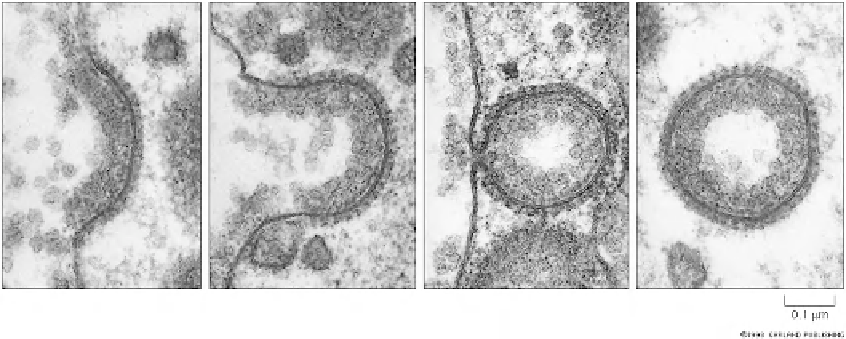Biology Reference
In-Depth Information
Clathrin-Coated Pits
Plasma membranes are in part characterized by having structures that facilitate uptake of
required solutes into the cell. An example of such a structure is the clathrin-coated pit, a struc-
ture that is involved in the process of receptor-mediated endocytosis (also referred to as cla-
thrin-dependent endocytosis). Specific receptors found in the outer leaflet of the plasma
membrane are involved in the internalization of macromolecules (ligands) including
hormones, growth factors, enzymes, serum proteins, cholesterol-containing lipoproteins,
antibodies, and ferritin-iron complexes. The best known example of this is the uptake of
cholesterol-containing low density lipoprotein (LDL) particles
[29]
, work that won Michael
Brown and Joseph Goldstein the 1986 Nobel Prize in Physiology and Medicine. Ligand-
receptor complexes diffuse laterally in the plasma membrane until they encounter a coated
pit where they become trapped. Proteins attached to the plasma membrane inner leaflet
including clathrin and two coat proteins, COPI and COPII, cause the pit to invaginate until
it pinches off, forming a vesicle free in the cytoplasm (
Figure 11.8
,
[30]
). The vesicle has three
possible fates: 1. It can travel to the lysosome for degradation; 2. It can go to the TGN (Trans-
Golgi Network) for transport through the endomembrane system; or 3. It can return back to
the plasma membrane at the opposite side of the cell where it is secreted as part of a process
called transcytosis
[31]
. Coated pits are quite abundant in the plasma membrane [
32
]. Since
they occupy ~20% of the total plasma membrane surface area and the entire process of inter-
nalization only takes about 1 minute, there may be 2,500 coated pits invaginating into vesicles
per minute in a cell. Another protein found associated with coated pits is caveolin, a major
component of caveolae, a type of lipid raft. Coated pits are twice the size of caveolae, but
share some common properties with caveolae and lipid rafts.
Caveolae
Caveolae are complex plasma membrane structures whose properties appear to
place them between coated pits and lipid rafts (discussed in Chapter 8). They are small
FIGURE 11.8
Sequence of formation of coated vesicles (right) from clathrin-coated pit (left) during receptor-
mediated endocytosis on the surface of the plasma membrane. Pictures are electron micrographs of yolk protein on
a chicken oocyte
[30]
.


